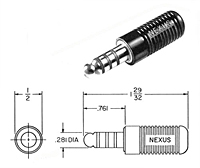Push to Talk (PTT) TroubleshootingUpdated 3 months ago
Enhanced DISCO32 Push to Talk (PTT) Troubleshooting Guide
Introduction
This guide is tailored to help users troubleshoot issues with DISCO32 Push to Talk (PTT) devices, with a focus on understanding the differences between dynamic and electret microphones and their compatibility with PTT devices.
Understanding Microphone Types
If your radio transmits when the PTT is depressed and you can hear audio in your headset but your voice isn't transmitted on the net you typically have a mic mismatch.
Dynamic Microphones
- Characteristics: Dynamic microphones are robust, handle high sound pressure levels well, and are generally less sensitive to moisture and temperature changes.
- Functionality: They work by converting sound into an electrical signal using electromagnetism and are typically low impedance.
- Compatibility: Dynamic mics are compatible with low impedance or amplified PTTs, commonly used in professional, military, and high-quality headsets like Ops-Core AMPs and Peltor COMTAC.
Electret Microphones
- Characteristics: Electret microphones are more common in consumer electronics. They are smaller, require less power, and are generally more sensitive than dynamic mics.
- Functionality: They use a permanently charged material to convert sound into an electrical signal and typically require a power source.
- Compatibility: Electret mics usually need high impedance PTTs and are often found in knock-off or cheaper headset options, its important that you contact DISCO32 if you have any questions prior to purchase.
Step-by-Step Troubleshooting
Step 1: Identify Your Microphone Type
- Check Microphone Type: Determine if your headset uses a dynamic or electret microphone.
- Brand Consideration: High-quality brands typically use dynamic mics, while cheaper or knock-off headsets often use electret mics all though this is not always the case with headset designed for the law enforcement market before the mass adoption of dynamic microphones.
- For quality brands like TEA or SORDIN you can check the microphone housing for an "E" that indicates the microphone is electret. PELTOR XPI users check the compatibility chart below in the wiring section.
Step 2: Assess PTT Button Functionality
- Transmission Test: Press the PTT button and check if the radio starts transmitting. No transmission could indicate a connectivity or hardware issue. Typically if the button on your push to talk triggers the radio to transmit and your microphone is not broadcasting on the radio it is a microphone impedance mismatch.
Step 3: Check Headset Compatibility
- Downlead Plug Types: Ensure your headset has a TP-101 downlead, some headsets will have a TP-105 downlead (red stripes) this plug is not compatible with DISCO32 push to talks.
 TP-101 (Black Stripes)
TP-101 (Black Stripes)
Compatible with DISCO32 PTTs TP-105 (Red Stripes)
TP-105 (Red Stripes)
Incompatible with DISCO32 PTTs TP-101 (U174/J11)
TP-101 (U174/J11)-1a2ead21-49a2-4a8a-9418-68e644afcfff.jpeg) TP-105 (Stereo J11)
TP-105 (Stereo J11)- NATO VS PELTOR Wiring: If you hear sound from your microphone it indicates a wiring mismatch caused by having PELTOR or civilian wiring on the plug. Peltor XPI users need to be mindful of their wiring type (See diagram below). Only NATO works with DISCO32 PTTs.
-c9b34ef9-7ff3-48cf-8b4a-03d5d98ab3aa.jpeg)
 XPI Compatibly List (DISCO32 Requires NATO J11 & FLEX or STANDARD MIC)
XPI Compatibly List (DISCO32 Requires NATO J11 & FLEX or STANDARD MIC)
Step 4: Troubleshoot Hybrid PTT/Speaker Mic Devices
- Functionality Check: For hybrid devices, ensure both PTT and speaker mic functionalities are working.
- Mode Switching: Test the switching between different communication modes to ensure seamless operation.
Step 5: Radio and Speaker Volume
- Volume Levels: Ensure the radio's volume is turned up and check the volume in the headset speaker. If there is no audio from the radio in your headset this could indicate a wiring type mismatch.
- With both improper wiring and a microphone impedance issue a button press will cause the radio to transmit but no audio will be present in the headset or the microphone.
- If there is just a wiring mismatch and you have a dynamic microphone audio will come from the microphone itself.
Step 6: Warranty and Support
- Warranty Claim: If you suspect a defect or manufacturing issue, check your warranty status and contact DISCO32 for support.
- Customer Support: For unresolved issues, reach out to DISCO32's customer support for assistance.
Step 7: Integration with Tactical Communication Systems
- Comprehensive Testing: Test the PTT device in conjunction with the entire communication setup to identify any compatibility or operational issues.
Step 8: Final Checks
- Jack and Connector Inspection: Examine the TJ-101 jack and other connectors for any physical damage or improper connection - a small gap is normal (it is there to make room for connectors with larger over molds).
- Mode (Digital/Analog) Related Issues: If you face mode-specific issues, contact DISCO32 for guidance.
Conclusion
By understanding the type of microphone in use and its compatibility with PTT devices, users can more effectively troubleshoot and resolve issues with their DISCO32 PTT devices. Regular maintenance and checks can prevent many common issues with PTT devices. If problems persist, seeking professional assistance from DISCO32's support team is recommended.
